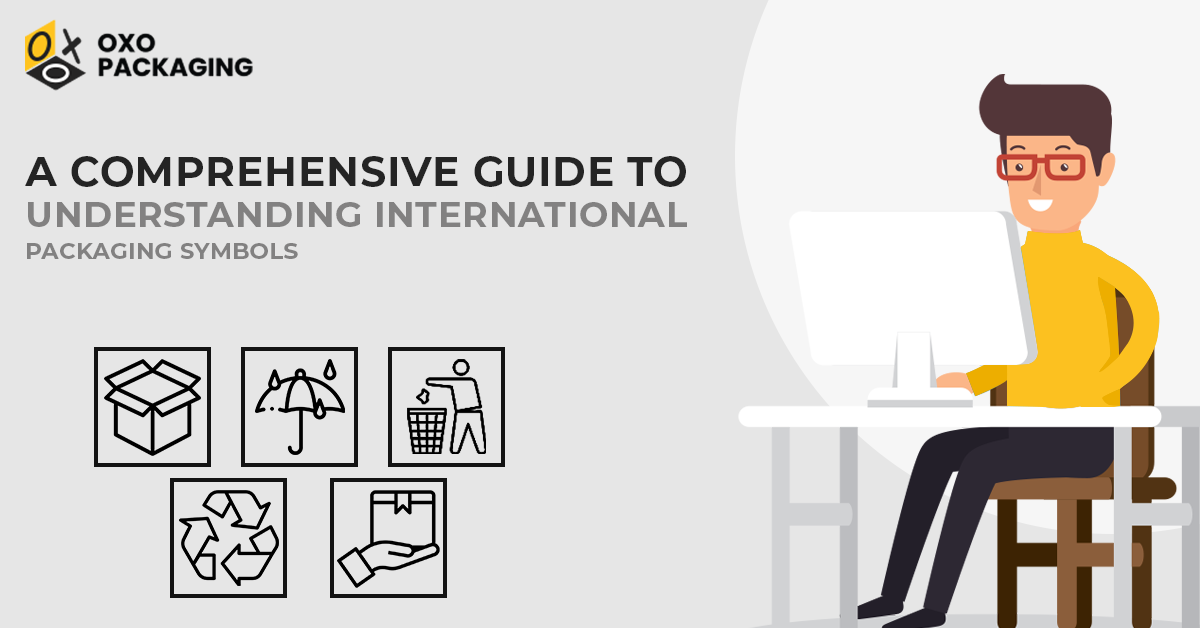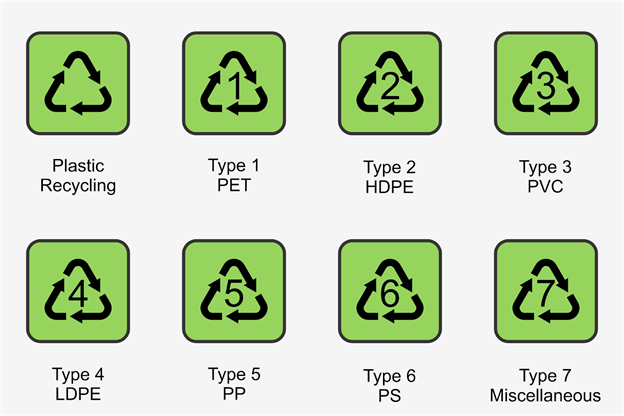A Comprehensive Guide to Understanding International Packaging Symbols

Have you ever read the symbols printed on your packaging and wondered what they all meant? There is always the use of one or more signs on the box, regardless of whether you received the packaging or your customer did.
Packaging symbols might look like squiggles and pictures but contain vital product information. These symbols are like secret codes that tell us how to use, store, and recycle things. Most of these symbols are entirely optional to use on your packages. However, using those that alert recipients or transporters to potential risks during transit is advisable.
We will decode some common packaging symbols in this easy-to-read guide to help you understand each symbol's meaning and how to use it on custom boxes when necessary.
So, without any further ado, let's dive into the world of packaging!
The Ultimate Guide to Packaging Symbols
A total of 25 packaging symbols have been issued by The International Organization for Standardization (ISO), which fall under the four main categories.
These categories include:
- Package Protection Symbols
- Package Handling Instructions
- Health and Safety Information
- Recycling Details
Below, we have comprehensively described these four categories and their packaging symbols.
1. Package Protection Symbols
Any product prone to damage during shipping requires package protection and care symbols. These images represent the product's characteristics without revealing the package's contents. A logo rather than a written summary makes packaging products easier to identify.
Here are the four symbols that fall under this category.
-
This Side Up
This typical packaging symbol denotes the presence of a complex product that must always be stored upright in the box. The contents of the box will suffer significant damage if they are stored, moved, or turned upside down. This symbol is two vertical arrows pointing upward, which is an easy way to recognize it.
Examples include large machinery and laboratory equipment.
-
Fragile
The fragile symbol is self-explanatory. This symbol looks like a glass and a hand. But sometimes, it is shown as broken glass. It's a gentle reminder that the item inside is delicate (glass/glass-like) and must be handled carefully. So, if you see this symbol on your package, be extra cautious.
Glass and porcelain products are two examples.
-
Handle with Care
This symbol is slightly different from the fragile one. The box with this symbol carries products that will not break or crack easily. However, they can get damaged if you do not handle them with care. Therefore, packages bearing this symbol must be laid flat without stacking.
Television sets, laptops, and smartphones are common products in this category.
-
Do Not Open with Knife
Using a knife to open the package may damage the contents. This symbol instructs the end user to open the box gently.
Mattresses, books, and pillows are common examples.
Safe Storage and Packing Symbols
Some packages contain delicate materials that are weak to the effects of the environment, such as water, UV light, or cold. Symbols for environmental protection give instructions on how to store packages properly.
The symbols that fall into this category are as follows:
-
Avoid Direct Sunlight
You will see food package symbols in which a unique shape partially covers the sun. This means the product (e.g., food) shouldn't be left in direct sunlight, which might affect its quality.
Posters, book covers, and liquids are a few examples.
-
Temperature Sensitive
Temperature sensitivity markings indicate a package's temperature tolerance range for shipping and storage. For long-distance and international shipping, this symbol is crucial.
Liquids and food products require this symbol on their packaging boxes.
-
Avoid Placing Near Magnets
Place this symbol on the box if your package contains sensitive electronic items. It shows that these boxes should be kept away from the magnets, as their magnetic field can harm them.
Examples: Hard Disk Drives.
-
Keep Dry
This symbol denotes that a product must avoid contacting water directly. Occasionally, this symbol will only have the umbrella, but more often than not, it will also have a symbol for a raindrop.
Examples include paper products and electronics.
2. Package Handling Symbols
The shipping symbols provide all the details required to transport a package safely. Both delivery staff and customers should follow these instructions. The packaging symbols listed below are frequently seen on commercial goods shipped in large quantities together.
-
Avoid Stacking
Some packaging is made with an emphasis on aesthetics rather than durability. The packaging material for these packages could deform under pressure if stacked on top of one another. In this case, the symbol depicts two boxes stacked with a cross over the top.
Instances: Decorative Gift Boxes
-
Recommended Stacking Height
Even robust packaging has limits and can only support a certain amount of weight. Such packages include a stacking height recommendation.
Examples: Milk and Juice Cartons.
Weight Information
Two factors need to be considered regarding the package’s weight. Those are:
-
Package Weight
For heavier items, the manufacturer often includes the weight on the box. This symbol prominently displays the total weight along with the appropriate measurement units.
-
Center of Gravity
The center of gravity is where most of the package's weight is concentrated. In the case of elongated packages, the side featuring this symbol will carry more weight since it supports most of the product's mass.
Lifting the Package
The packaging boxes need to be carried with care. These four main symbols show that one should carry the package.
-
Requires Two People to Lift
This icon denotes that a package is too large or too heavy to be lifted by one person. While you can lift such boxes independently, doing so is not advised.
-
Do Not Try to Lift
The "do not lift" symbols on packages appear on particularly heavy boxes. This icon is especially helpful for concealing small but deceptively heavy packages.
-
Lift Using a Trolley
This icon is used for bulky items that are challenging to carry by hand, even with several people. It is highly advised to use weightlifters or trolleys for such packages.
-
Do Not Use Hook to Lift
Some packages are too heavy to even carry by the hook. If you lift them with a hook, they will tear open from the bottom.
3. Health and Safety Information
When it comes to safety, packaging symbols are like little helpers that tell us important things. Let's break down some symbols to make them easy to understand.
Product Safety First
Safety indicators let consumers know that a product's packaging and contents have undergone some sort of quality control inspection.
-
Safe for Food
Imagine symbols on food packaging that show it's safe for food. It's like a food-friendly badge. But remember, the maker decides this, and not all countries check it.
Examples: Fruits and Veggies.
-
CE Mark - Safety in Europe
The letters CE stand for European Conformity. If you see this on a package, it means it meets European safety rules. But don't use it without permission - it's like borrowing without asking.
-
Watch Out for Dangers
Some packages have tricky stuff inside, like things that can catch fire. These packages carry a warning. It's like the package saying, "Hey, be careful!"
Potential Hazards
Packages containing volatile materials or carrying ignition risk must be printed with hazard warnings. Good packaging correctly conveys all the important information about the handling of a product.
-
Don't Play with Fire
If the stuff in the package can catch fire, these symbols on packaging will appear. It's like a warning sign for fire danger.
Examples: Paper Products.
-
Be Careful
This symbol is like a friendly warning. It always has more words hidden behind the symbol to tell you why you should be cautious.
Example: Chemicals and Batteries.
4. Recycling Symbols - Be Kind to Earth
Even though no one forces us, recycling is a good deed for our planet. These recycling signs talk about the package and what's inside.
-
Check the Recycling Labels
Imagine a sign that tells you the package can be recycled. It's like a "go ahead" for putting it in the recycling bin. The number in the middle shows how much of it is made from old stuff.
-
Keep It Tidy
This little person in the symbol reminds us not to mess up the earth. People know this sign well in the UK and USA, but it might look strange elsewhere.
Certified Packages - Official Stamps
You may print a third party's certification symbol on a package if that organization has approved it.
-
FSC (Forest Stewardship Council)
Think of this like a badge for good wood. If you see it, the package's wood came from a place where trees are looked after. It guarantees that the packaging satisfies the necessary standards for sustainability. It is not a requirement set forth by law.
-
Corrugated Case Association
This symbol says that the cardboard can be used again. But it doesn't tell us if it's old cardboard. There are other signs of that.
Plastic Recycling Symbols
Depending on the type of plastic recycled, plastic recycling signs may vary. The recycle sign with a number in the center represents it. You can determine what kind of plastic was recycled and used by looking at the number.
Here's a simple chart to help you figure out what the symbols mean:

So, the next time you see these symbols on packages, remember they are like secret messages helping us stay safe, kind to the Earth, and smart about what we use!
Wrapping It Up!
Understanding packaging symbols is like having a conversation with the package itself. These symbols guide you in treating the box as it deserves, preventing accidents, and preserving the contents.
So, the next time you face a box covered in symbols, remember that it's just the package telling you how it wants to be treated.




